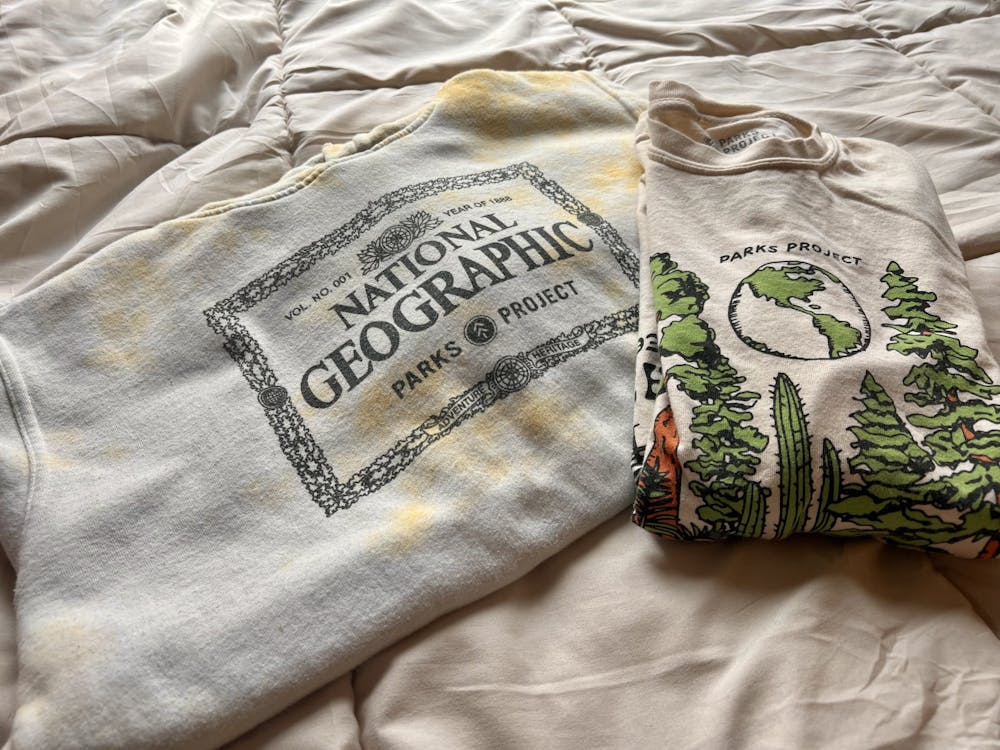Artistic interpretations of Yellow Stone’s geysers, Zion’s canyons, monarch butterflies and magic mushrooms have exploded onto the rack in big-name stores while climate disaster worsens and 58 percent of Americans believe policymakers aren’t doing enough.
Parks Project is the nonprofit arm of the National Parks Service (NPS), sustainably creating and producing fashion to preserve underfunded national parks. The project was joined by big-name outdoor brands such as REI, Pendleton and L.L. Bean to increase NPS profit.
Outside of the Parks Project, corporations such as Target are increasing consumer attention toward environmental aesthetics by launching mycology-themed and “Save the Earth” clothing lines.
John Paul Mejia, a junior in the College of Arts and Sciences and national spokesperson for Sunrise Movement, said this trend demonstrates a degree of environmental awareness and an aesthetic appreciation that is intrinsic to humanity.
“Those of us at the bottom of the economic ladder or have neighborhoods that are slashed by the inequalities of race and class have differing accessibility to nature,” Mejia said. “I think that fashion and a yearn for nature speaks to some of that inaccessibility.”
The biodiversity within nature has inspired fashion for centuries: from European textiles to Islamic geometric patterns and Indigenous American tapestries, each conveys earthly reverence. Trending vintage illustrations of nature harken to a hopeful time without the looming presence of climate change.
“Being able to imagine and articulate a future that is good is something that’s sometimes hard to do,” Mejia said. “That requires a lot of labor, a lot of hope and the absence of cynicism. Those things are hard to do when all you see is bad days all around.”
Trendsetting and statement pieces come with caveats. In the process of bringing designer looks to the public, fast fashion companies break labor rights and cause extreme environmental degradation.
Meanwhile, sustainable fashion negates environmental impact but is often too expensive for the average consumer. The average cost for a Parks Project t-shirt or tank top is $31.97, and REI charges an average of $42.00 for a Parks Project item.
Michael Taffe, a junior in CAS, saw an Instagram advertisement for the Parks Project in 2020 and has been wearing their gear since. He said he loves the retro design and feels the purpose is worth the price.
“It makes me feel a little bit better about it because I know it’s going to a good cause,” Taffe said.
Alongside preserving parklands, Taffe believes businesses using parkland imagery should acknowledge the lives and homes stolen to build national parks.
“I think the Indigenous story needs to be told,” Taffe said. “Reparations should be part of these brands if they truly want to be equitable.”
Few Americans are aware of the national parks’ brutal history. To mold American landscapes into untouched wilderness, the Federal Government authorized the displacement of its Indigenous inhabitants. Without cruelty, illustrations of the undiscovered wild would not be present for marketing.
In September 2022, NPS partnered with American Indian and Alaska Native Tribes, Alaska Natives entities and the Native Hawaiian Community for future national parkland management.
Molly Stites, president of Wonk Trade, a student-run trading and exchange post at AU, and a third year in the School of Communication, said too many Americans romanticize national parks as the paradigm of sustainability.
“I love national parks, but there are many other levels of sustainability and environmental justice that people should be focusing on,” Stites said. “It’s really important to dig deeper into that and open your eyes up to thrifting.”
Scrolling through Parks Project apparel and searching the racks of REI, the wandering eye is drawn to retro screen presses of parklands and scientific sketches of the natural world. New and recycled interpretations of the Earth stand in sharp contrast to the everyday images of climate disaster.
While these illustrations provide nostalgia for a time without the eclipsing presence of climate change, recognizing the origins of the land motivates climate action.
“This nostalgia,” Mejia said, “Whether it is aesthetic or political, helps us imagine different moments in which social movements and artists and other folks who have employed their political and artistic agency have reshaped the country.”





